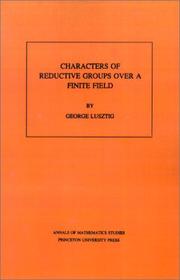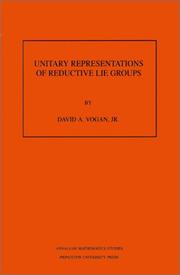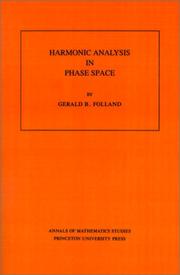| Listing 1 - 5 of 5 |
Sort by
|

ISBN: 0691082286 0691082324 1400881579 Year: 1979 Publisher: Princeton (N.J.) Princeton university press
Abstract | Keywords | Export | Availability | Bookmark
 Loading...
Loading...Choose an application
- Reference Manager
- EndNote
- RefWorks (Direct export to RefWorks)
Based on a seminar sponsored by the Institute for Advanced Study in 1977-1978, this set of papers introduces micro-local analysis concisely and clearly to mathematicians with an analytical background. The papers treat the theory of microfunctions and applications such as boundary values of elliptic partial differential equations, propagation of singularities in the vicinity of degenerate characteristics, holonomic systems, Feynman integrals from the hyperfunction point of view, and harmonic analysis on Lie groups.
Mathematical analysis --- Differential geometry. Global analysis --- 517.98 --- -Advanced calculus --- Analysis (Mathematics) --- Algebra --- Functional analysis and operator theory --- Addresses, essays, lectures --- Mathematical analysis. --- Addresses, essays, lectures. --- -517.1 Mathematical analysis --- 517.98 Functional analysis and operator theory --- -Functional analysis and operator theory --- -517.98 Functional analysis and operator theory --- 517.1 Mathematical analysis --- 517.1. --- 517.1 --- Addition. --- Analytic function. --- Analytic manifold. --- Asymptotic analysis. --- Bernhard Riemann. --- Boundary value problem. --- Bounded operator. --- Cartan subgroup. --- Characterization (mathematics). --- Class function (algebra). --- Closed-form expression. --- Codimension. --- Cohomology. --- Compact space. --- Comparison theorem. --- Contact geometry. --- Continuous function. --- Continuous linear operator. --- Convex hull. --- Cotangent bundle. --- D-module. --- Degenerate bilinear form. --- Diagonal matrix. --- Differentiable manifold. --- Differential operator. --- Dimension (vector space). --- Dimension. --- Elliptic partial differential equation. --- Equation. --- Existence theorem. --- Fourier integral operator. --- Generic point. --- Group theory. --- Harmonic analysis. --- Holomorphic function. --- Holonomic. --- Homogeneous space. --- Hyperfunction. --- Hypersurface. --- Identity element. --- Irreducible representation. --- Killing form. --- Lagrangian (field theory). --- Lie algebra. --- Lie group. --- Linear differential equation. --- Locally compact space. --- Masaki Kashiwara. --- Maximal ideal. --- Monodromy. --- Natural number. --- Neighbourhood (mathematics). --- Ordinary differential equation. --- Orthogonal complement. --- Partial differential equation. --- Path integral formulation. --- Proper map. --- Pseudo-differential operator. --- Regularity theorem. --- Sigurdur Helgason (mathematician). --- Submanifold. --- Subset. --- Summation. --- Symmetric space. --- Symplectic geometry. --- Tangent cone. --- Theorem. --- Topological space. --- Vector bundle. --- Victor Guillemin. --- Weyl group. --- Analyse microlocale

ISBN: 0691083509 0691083517 1400881773 9780691083513 9780691083506 Year: 1984 Volume: 107 Publisher: Princeton, N.J.
Abstract | Keywords | Export | Availability | Bookmark
 Loading...
Loading...Choose an application
- Reference Manager
- EndNote
- RefWorks (Direct export to RefWorks)
This book presents a classification of all (complex)irreducible representations of a reductive group withconnected centre, over a finite field. To achieve this,the author uses etale intersection cohomology, anddetailed information on representations of Weylgroups.
512 --- Characters of groups --- Finite fields (Algebra) --- Finite groups --- Groups, Finite --- Group theory --- Modules (Algebra) --- Modular fields (Algebra) --- Algebra, Abstract --- Algebraic fields --- Galois theory --- Characters, Group --- Group characters --- Groups, Characters of --- Representations of groups --- Rings (Algebra) --- Algebra --- 512 Algebra --- Finite groups. --- Characters of groups. --- Addition. --- Algebra representation. --- Algebraic closure. --- Algebraic group. --- Algebraic variety. --- Algebraically closed field. --- Bijection. --- Borel subgroup. --- Cartan subalgebra. --- Character table. --- Character theory. --- Characteristic function (probability theory). --- Characteristic polynomial. --- Class function (algebra). --- Classical group. --- Coefficient. --- Cohomology with compact support. --- Cohomology. --- Combination. --- Complex number. --- Computation. --- Conjugacy class. --- Connected component (graph theory). --- Coxeter group. --- Cyclic group. --- Cyclotomic polynomial. --- David Kazhdan. --- Dense set. --- Derived category. --- Diagram (category theory). --- Dimension. --- Direct sum. --- Disjoint sets. --- Disjoint union. --- E6 (mathematics). --- Eigenvalues and eigenvectors. --- Endomorphism. --- Equivalence class. --- Equivalence relation. --- Existential quantification. --- Explicit formula. --- Explicit formulae (L-function). --- Fiber bundle. --- Finite field. --- Finite group. --- Fourier transform. --- Green's function. --- Group (mathematics). --- Group action. --- Group representation. --- Harish-Chandra. --- Hecke algebra. --- Identity element. --- Integer. --- Irreducible representation. --- Isomorphism class. --- Jordan decomposition. --- Line bundle. --- Linear combination. --- Local system. --- Mathematical induction. --- Maximal torus. --- Module (mathematics). --- Monodromy. --- Morphism. --- Orthonormal basis. --- P-adic number. --- Parametrization. --- Parity (mathematics). --- Partially ordered set. --- Perverse sheaf. --- Pointwise. --- Polynomial. --- Quantity. --- Rational point. --- Reductive group. --- Ree group. --- Schubert variety. --- Scientific notation. --- Semisimple Lie algebra. --- Sheaf (mathematics). --- Simple group. --- Simple module. --- Special case. --- Standard basis. --- Subset. --- Subtraction. --- Summation. --- Surjective function. --- Symmetric group. --- Tensor product. --- Theorem. --- Two-dimensional space. --- Unipotent representation. --- Vector bundle. --- Vector space. --- Verma module. --- Weil conjecture. --- Weyl group. --- Zariski topology.

ISBN: 0691084815 0691084823 1400882389 9780691084824 9780691084817 Year: 1987 Publisher: Princeton Princeton University Press
Abstract | Keywords | Export | Availability | Bookmark
 Loading...
Loading...Choose an application
- Reference Manager
- EndNote
- RefWorks (Direct export to RefWorks)
This book is an expanded version of the Hermann Weyl Lectures given at the Institute for Advanced Study in January 1986. It outlines some of what is now known about irreducible unitary representations of real reductive groups, providing fairly complete definitions and references, and sketches (at least) of most proofs. The first half of the book is devoted to the three more or less understood constructions of such representations: parabolic induction, complementary series, and cohomological parabolic induction. This culminates in the description of all irreducible unitary representation of the general linear groups. For other groups, one expects to need a new construction, giving "unipotent representations." The latter half of the book explains the evidence for that expectation and suggests a partial definition of unipotent representations.
Lie groups --- Representations of Lie groups --- Lie groups. --- Representations of Lie groups. --- 512.81 --- Groups, Lie --- Lie algebras --- Symmetric spaces --- Topological groups --- 512.81 Lie groups --- Abelian group. --- Adjoint representation. --- Annihilator (ring theory). --- Atiyah–Singer index theorem. --- Automorphic form. --- Automorphism. --- Cartan subgroup. --- Circle group. --- Class function (algebra). --- Classification theorem. --- Cohomology. --- Commutator subgroup. --- Complete metric space. --- Complex manifold. --- Conjugacy class. --- Cotangent space. --- Dimension (vector space). --- Discrete series representation. --- Dixmier conjecture. --- Dolbeault cohomology. --- Duality (mathematics). --- Eigenvalues and eigenvectors. --- Exponential map (Lie theory). --- Exponential map (Riemannian geometry). --- Exterior algebra. --- Function space. --- Group homomorphism. --- Harmonic analysis. --- Hecke algebra. --- Hilbert space. --- Hodge theory. --- Holomorphic function. --- Holomorphic vector bundle. --- Homogeneous space. --- Homomorphism. --- Induced representation. --- Infinitesimal character. --- Inner automorphism. --- Invariant subspace. --- Irreducibility (mathematics). --- Irreducible representation. --- Isometry group. --- Isometry. --- K-finite. --- Kazhdan–Lusztig polynomial. --- Langlands decomposition. --- Lie algebra cohomology. --- Lie algebra representation. --- Lie algebra. --- Lie group action. --- Lie group. --- Mathematical induction. --- Maximal compact subgroup. --- Measure (mathematics). --- Minkowski space. --- Nilpotent group. --- Orbit method. --- Orthogonal group. --- Parabolic induction. --- Principal homogeneous space. --- Principal series representation. --- Projective space. --- Pseudo-Riemannian manifold. --- Pullback (category theory). --- Ramanujan–Petersson conjecture. --- Reductive group. --- Regularity theorem. --- Representation of a Lie group. --- Representation theorem. --- Representation theory. --- Riemann sphere. --- Riemannian manifold. --- Schwartz space. --- Semisimple Lie algebra. --- Sheaf (mathematics). --- Sign (mathematics). --- Special case. --- Spectral theory. --- Sub"ient. --- Subgroup. --- Support (mathematics). --- Symplectic geometry. --- Symplectic group. --- Symplectic vector space. --- Tangent space. --- Tautological bundle. --- Theorem. --- Topological group. --- Topological space. --- Trivial representation. --- Unitary group. --- Unitary matrix. --- Unitary representation. --- Universal enveloping algebra. --- Vector bundle. --- Weyl algebra. --- Weyl character formula. --- Weyl group. --- Zariski's main theorem. --- Zonal spherical function. --- Représentations de groupes de Lie --- Groupes de lie --- Representation des groupes de lie
Book
ISBN: 0691082464 069161136X 1400871131 069163937X 9780691082462 Year: 1979 Publisher: Princeton (N.J.): Princeton university press
Abstract | Keywords | Export | Availability | Bookmark
 Loading...
Loading...Choose an application
- Reference Manager
- EndNote
- RefWorks (Direct export to RefWorks)
Based on a series of lectures given by Harish-Chandra at the Institute for Advanced Study in 1971-1973, this book provides an introduction to the theory of harmonic analysis on reductive p-adic groups.Originally published in 1979.The Princeton Legacy Library uses the latest print-on-demand technology to again make available previously out-of-print books from the distinguished backlist of Princeton University Press. These editions preserve the original texts of these important books while presenting them in durable paperback and hardcover editions. The goal of the Princeton Legacy Library is to vastly increase access to the rich scholarly heritage found in the thousands of books published by Princeton University Press since its founding in 1905.
512.74 --- p-adic groups --- Banach algebras --- Groups, p-adic --- Algebraic groups. Abelian varieties --- p-adic groups. --- 512.74 Algebraic groups. Abelian varieties --- P-adic groups. --- Harmonic analysis. Fourier analysis --- Harmonic analysis --- Analysis (Mathematics) --- Functions, Potential --- Potential functions --- Calculus --- Mathematical analysis --- Mathematics --- Bessel functions --- Fourier series --- Harmonic functions --- Time-series analysis --- Group theory --- Harmonic analysis. --- Adjoint representation. --- Admissible representation. --- Algebra homomorphism. --- Algebraic group. --- Analytic continuation. --- Analytic function. --- Associative property. --- Automorphic form. --- Automorphism. --- Banach space. --- Bijection. --- Bilinear form. --- Borel subgroup. --- Cartan subgroup. --- Central simple algebra. --- Characteristic function (probability theory). --- Characterization (mathematics). --- Class function (algebra). --- Commutative property. --- Compact space. --- Composition series. --- Conjugacy class. --- Corollary. --- Dimension (vector space). --- Discrete series representation. --- Division algebra. --- Double coset. --- Eigenvalues and eigenvectors. --- Endomorphism. --- Epimorphism. --- Equivalence class. --- Equivalence relation. --- Existential quantification. --- Factorization. --- Fourier series. --- Function (mathematics). --- Functional equation. --- Fundamental domain. --- Fundamental lemma (Langlands program). --- G-module. --- Group isomorphism. --- Haar measure. --- Hecke algebra. --- Holomorphic function. --- Identity element. --- Induced representation. --- Inner automorphism. --- Lebesgue measure. --- Levi decomposition. --- Lie algebra. --- Locally constant function. --- Locally integrable function. --- Mathematical induction. --- Matrix coefficient. --- Maximal compact subgroup. --- Meromorphic function. --- Module (mathematics). --- Module homomorphism. --- Open set. --- Order of integration (calculus). --- Orthogonal complement. --- P-adic number. --- Pole (complex analysis). --- Product measure. --- Projection (linear algebra). --- Quotient module. --- Quotient space (topology). --- Radon measure. --- Reductive group. --- Representation of a Lie group. --- Representation theorem. --- Representation theory. --- Ring homomorphism. --- Schwartz space. --- Semisimple algebra. --- Separable extension. --- Sesquilinear form. --- Set (mathematics). --- Sign (mathematics). --- Square-integrable function. --- Sub"ient. --- Subalgebra. --- Subgroup. --- Subset. --- Summation. --- Support (mathematics). --- Surjective function. --- Tempered representation. --- Tensor product. --- Theorem. --- Topological group. --- Topological space. --- Topology. --- Trace (linear algebra). --- Transitive relation. --- Unitary representation. --- Universal enveloping algebra. --- Variable (mathematics). --- Vector space. --- Analyse harmonique (mathématiques)

ISBN: 0691085277 0691085285 1400882427 9780691085289 9780691085272 Year: 1989 Volume: 122 Publisher: Princeton (N.J.): Princeton university press
Abstract | Keywords | Export | Availability | Bookmark
 Loading...
Loading...Choose an application
- Reference Manager
- EndNote
- RefWorks (Direct export to RefWorks)
This book provides the first coherent account of the area of analysis that involves the Heisenberg group, quantization, the Weyl calculus, the metaplectic representation, wave packets, and related concepts. This circle of ideas comes principally from mathematical physics, partial differential equations, and Fourier analysis, and it illuminates all these subjects. The principal features of the book are as follows: a thorough treatment of the representations of the Heisenberg group, their associated integral transforms, and the metaplectic representation; an exposition of the Weyl calculus of pseudodifferential operators, with emphasis on ideas coming from harmonic analysis and physics; a discussion of wave packet transforms and their applications; and a new development of Howe's theory of the oscillator semigroup.
Harmonic analysis. Fourier analysis --- Phase space (Statistical physics) --- Harmonic analysis --- 512.54 <043> --- 530.145 <043> --- 517.986.6 --- 51-7 <043> --- 517.986.6 <043> --- Groups. Group theory--Dissertaties --- Quantum theory--Dissertaties --- Harmonic analysis of functions of groups and homogeneous spaces --- Mathematical studies and methods in other sciences. Scientific mathematics. Actuarial mathematics. Biometrics. Econometrics etc.--Dissertaties --- Harmonic analysis of functions of groups and homogeneous spaces--Dissertaties --- 517.986.6 <043> Harmonic analysis of functions of groups and homogeneous spaces--Dissertaties --- 51-7 <043> Mathematical studies and methods in other sciences. Scientific mathematics. Actuarial mathematics. Biometrics. Econometrics etc.--Dissertaties --- 517.986.6 Harmonic analysis of functions of groups and homogeneous spaces --- 530.145 <043> Quantum theory--Dissertaties --- 512.54 <043> Groups. Group theory--Dissertaties --- Space, Phase (Statistical physics) --- Generalized spaces --- Analysis (Mathematics) --- Functions, Potential --- Potential functions --- Banach algebras --- Calculus --- Mathematical analysis --- Mathematics --- Bessel functions --- Fourier series --- Harmonic functions --- Time-series analysis --- Harmonic analysis. --- Analytic continuation. --- Analytic function. --- Antisymmetric tensor. --- Asymptotic expansion. --- Automorphism. --- Bilinear form. --- Bounded operator. --- Calculation. --- Canonical commutation relation. --- Canonical transformation. --- Cauchy–Riemann equations. --- Cayley transform. --- Class function (algebra). --- Classical mechanics. --- Commutative property. --- Complex analysis. --- Configuration space. --- Differential equation. --- Differential geometry. --- Differential operator. --- Eigenvalues and eigenvectors. --- Equation. --- Explicit formula. --- Fock space. --- Fourier analysis. --- Fourier integral operator. --- Fourier transform. --- Functional analysis. --- Gaussian function. --- Gaussian integral. --- Geometric quantization. --- Hamiltonian mechanics. --- Hamiltonian vector field. --- Heisenberg group. --- Hermite polynomials. --- Hermitian symmetric space. --- Hilbert space. --- Hilbert transform. --- Integral transform. --- Invariant subspace. --- Irreducible representation. --- Lebesgue measure. --- Lie algebra. --- Lie superalgebra. --- Lie theory. --- Mathematical physics. --- Number theory. --- Observable. --- Ordinary differential equation. --- Orthonormal basis. --- Oscillator representation. --- Oscillatory integral. --- Partial differential equation. --- Phase factor. --- Phase space. --- Point at infinity. --- Poisson bracket. --- Polynomial. --- Power series. --- Probability. --- Projection (linear algebra). --- Projective Hilbert space. --- Projective representation. --- Projective space. --- Pseudo-differential operator. --- Pullback (category theory). --- Quadratic function. --- Quantum harmonic oscillator. --- Quantum mechanics. --- Representation theory. --- Schrödinger equation. --- Self-adjoint operator. --- Semigroup. --- Several complex variables. --- Siegel disc. --- Sobolev space. --- Spectral theorem. --- Spectral theory. --- State-space representation. --- Stone's theorem. --- Stone–Weierstrass theorem. --- Summation. --- Symmetric space. --- Symmetric tensor. --- Symplectic geometry. --- Symplectic group. --- Symplectic vector space. --- Symplectomorphism. --- Tangent space. --- Tangent vector. --- Theorem. --- Translational symmetry. --- Unbounded operator. --- Unit vector. --- Unitarity (physics). --- Unitary operator. --- Unitary representation. --- Variable (mathematics). --- Wave packet.
| Listing 1 - 5 of 5 |
Sort by
|

 Search
Search Feedback
Feedback About UniCat
About UniCat  Help
Help News
News